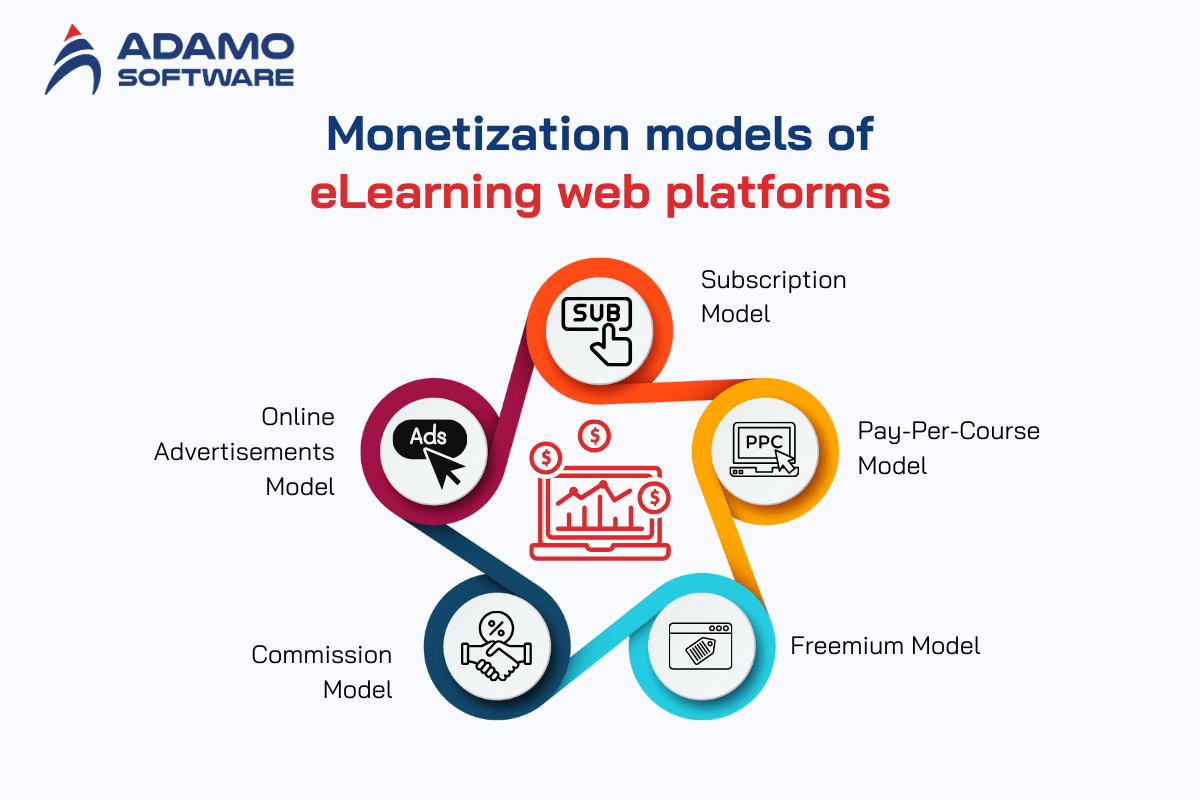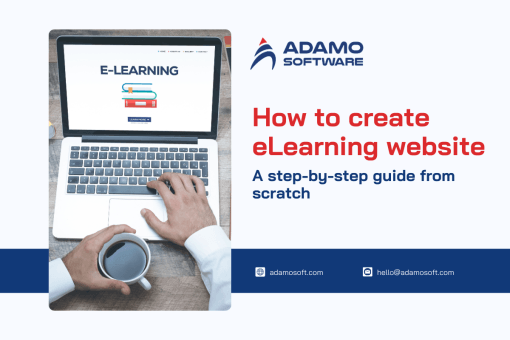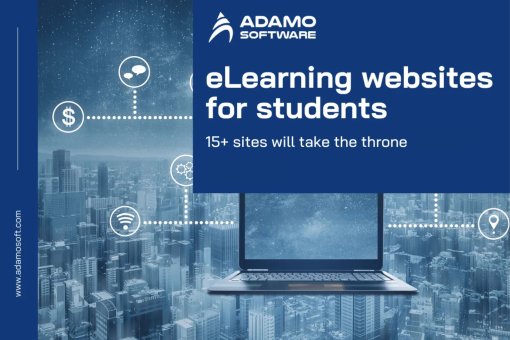All about eLearning web platforms: Market potential, types and monetization models

Interactive technology has changed the field of education profoundly. Nowadays, modern education relies on eLearning web platforms as essential tools. These applications deliver diverse learning methods that address different learning styles and preferences. eLearning web platforms have become a popular choice for learners because they can access learning materials whenever they want. Hence, grasping the market potential of online learning grows more critical as it expands.
These eLearning web platforms offer a vast range of benefits, one of which being a variety of online courses. In addition to that, these platforms allow students to learn on their own terms, fostering more accessible education. Thanks to the incorporation of many dynamic features and diverse content, the quality of education has been dramatically improved.
Moreover, eLearning web platforms are also an alternate way for educators to diversify their earnings. There are quite a few ways to earn income from these platforms, one popular example of which is the subscription model. As online learning becomes more popular among learners, the competitive landscape for educational offerings also grows more intense. Hence, educators must soon realize the enormous advantages of eLearning web platforms and incorporate them into their systems.
If you’re new to the business of eLearning web platforms, this article would be a great place to start. We’ll go from the basics, like understanding what eLearning web platforms are, to exploring the various monetization models for these platforms. Understanding the tools and the ways to use them effectively will be your single most important step to being ahead of the game.
I. What are eLearning web platforms?
eLearning web platforms, or online learning platforms, are the means for conducting educational activities in a virtual setting. What this means is that if students are connected to the Internet, they can learn from just about anywhere in the world. Apart from flexibility in terms of location, these platforms provide a very engaging study environment.
A good example of this could be the discussion section. This feature allows students to actively involve in discussions with peers from all around the world. As a result, they can form a more diverse point of view on different topics and aid in developing critical thinking.
Other examples of interesting features of e-learning platforms are quizzes or daily quests. These can make the study experience more fun and keep students committed to their learning. The efficiency of e-learning platforms has many times been proven with research. One research indicated that 90% of students find the online learning experience superior to the traditional one.
It is obvious that learners can all benefit from e-learning platforms’ adaptability and ease of learning, which give them space to personalize their study.
Also read: eLearning websites: Must-have features and advice for a lucrative platform
II. How does an e-learning web app work?
E-learning platforms reside on web servers, allowing users to reach them swiftly from any device connected to the internet. Unlike conventional e-learning platforms that typically provide only fixed content, e-learning websites support many engaging activities. Through these platforms, students have the opportunity to complete real-time activities like presenting and submitting assignments. Additionally, they can also engage in teamwork and complete assignments with peers from all parts of the world.
An important thing about eLearning web platforms is that they allow for the use of softwares like Zoom to do video conferencing. With this feature, teachers can conduct online classes anywhere and still maintain real-time interaction with students. Hence, students can get feedback from teachers and answers to their questions almost immediately. Moreover, students can get study materials whenever they need which increases the flexibility in learning.
With eLearning web platforms, educational institutions can still offer teacher-student engagement like traditional classrooms and keep the students connected to their learning. It is indeed great news that access to education is now easier than ever for students across the world with these technologies.
III. Overview about market potential for eLearning web platforms
eLearning web platforms were an indispensable part of education back when we were still coping with the Covid-19 global pandemic. Teachers utilize these platforms to send course resources, including audio and recorded videos, hence providing better access to learning. Students also benefit from learning on eLearning web platforms. Specifically, 31% of college students have reported that tools like chat boxes and interactive whiteboards are helpful for their studies.
Ever since then, because of their ease of use and versatility, the market for eLearning web platforms has been significantly expanding. Thanks to these tools, students can study from any location anytime with any tool they prefer. Their adaptability has made eLearning web platforms attractive to students around the globe.

These platforms have proven their effectiveness in aiding students with their learning journey. Specifically, 86% of graduate online students point out that their degree’s value was worth their investment. In addition, 96% of students assess that their instructors have successfully embraced online teaching.
The expansion of eLearning web platforms depends on their capability to present diverse content styles, including videos and audio. Indeed, having a wide variety of materials improves the engagement and effectiveness of instruction. In fact, studies indicate that students keep between 25% and 60% of course content on e-learning platforms. It seems that eLearning web platforms offer excellent education because they have unlimited geographical reach and 24-hour content availability.
As eLearning web platforms continue to advance, their market capacity is predicted to increase to satisfy the growing interest in innovative education methods. These platforms allow for both comfort and possibilities for lifelong education, thus becoming important in contemporary education.
IV. Popular types of eLearning web platforms
Various eLearning web platforms have appeared over the last 20 years. These applications fulfill diverse educational interests while improving the reach and usefulness of online learning. We’ll go through some popular types of eLearning web platforms in the following part:

1. Learning Destination Sites
Learning destination sites are the type in which various ranges of online courses are available on one-stop learning destination sites. They bring diverse educational content together for students to access faster.
The traditional version of this type involves preparing training materials with built-in features and then uploading them for distribution. These platforms usually provide tools for eCommerce to support financial transactions regarding course sales. Additionally, they have various features that assist creators to interact with students well and oversee their development.
Notable examples of learning destination sites like Udemy and Coursera represent the forefront of web-based learning solutions. They deliver exceptional teaching materials from specialists and accredited organizations all around the world.
2. Traditional Learning Management Systems
Traditional LMS focuses on content sharing and training activities at the corporate level and supports other educational goals. These systems allow instructors to structure lessons on their own and arrange study materials as they monitor learner’s achievements.
Content developers and instructors can also handle administrative work, including adding students to the course and following course progress. This attention to accessibility helps teachers to conduct training efficiently.
In the present market landscape, there are several popular providers of traditional learning management software, including BlueVolt and CrossKnowledge. Specifically, these eLearning web platforms are commonly implemented to improve employee training and learning.
3. Open-Source Learning Management Systems
Open-source learning management systems are specially designed to create and manage learning resources. These open-source platforms attract a diverse user base.
They are different from the traditional type in that they often allow unlimited customization at no charge. Well-known open-source learning management systems are Moodle, Sakai, and ILIAS.
Due to their ability to customize content on-demand, open-source platforms draw the attention of both educational institutions and independent content creators. Several businesses even specialize in modifying these systems to deliver support and improvements, allowing users to improve their instructional settings.
These systems have become famous thanks to their solid capabilities and active community assistance, creating valuable assets for customized education initiatives.
4. Custom Built Learning Platforms
Custom-built learning platforms are tailored learning platforms for the specific needs of each business or institution. By working with software development companies, organizations can create a learning platform that is suitable for their objectives and goals. As a result, this approach facilitates the development of entirely personalized software with all the necessary functions.
As the priciest choice among eLearning web platforms, custom solutions deliver incomparable control and flexibility. Businesses can build their platforms directly from scratch to ensure they meet every educational standard. This versatility supports persistent growth based on feedback from users and the dynamics of education needs.
HBS Online of Havard Business School is one notable example of a custom-built e-learning web platform. It perfectly showcases how tailored solutions can create effective and excellent educational materials.
5. Learning Management Ecosystems
Learning management ecosystems is a cutting-edge framework that has some of the leading solutions all in one educational web platform. These ecosystems deliver a strong and synchronized system for learners by uniting different tools and resources.
The ecosystems consist of several parts, including educational applications assessment tools, online sales tools, and content management systems. The combination improves user experience in education by providing a smooth interaction with the system. In most cases, custom interfaces are built to aid navigation and provide a cohesive structure.
A good example of this type is Adobe eLearning Suite. It is a platform that has various Adobe applications all tailored to learning purposes. Hence, it gives designers, managers, and many others the assets they need, accommodating diverse communities and training requirements.
V. Monetization models for eLearning web platforms

1. Subscription Model
As mentioned from the beginning, the subscription model is undoubtedly among the most popular monetization models for online services. Basically, with this model, users must pay a recurring fee for every predetermined time period to access the courses. In most cases, the payment period can be monthly, quarterly, or yearly.
Upon enrollment, a learner will have the ability to use all offered courses while their subscription is in effect. When their subscription ends, learners must update their payment to keep access to the contents. This system attracts learners and providers since it generates a consistent income for the e-learning website.
Users’ continuous participation is promoted as they are encouraged to complete courses and gain maximum benefits from their subscriptions. Several effective e-learning sites apply this system to offer continuous benefits to their users and maintain profitability.
2. Pay-Per-Course Model
Many eLearning web platforms utilize another type of monetization model: pay-per-course. Under this model, learners must pay for every course or topic in which they wish to participate. Once payment is made, students gain permanent permission to view the course content.
This framework allows learners to easily decide on courses related to their passions and what they need. Should someone wish to learn about a particular theme, they can buy the course without any extra cost.
Udemy is a popular platform that functions effectively based on this model, and it provides diverse courses in multiple subjects. This method is perfect for those who enjoy tailored learning and only want to pay for what they need. Moreover, this strategy can motivate users to explore diverse themes without having to deal with permanent financial responsibilities.
3. Freemium Model
Multiple e-learning sites have chosen the freemium approach as a strategic choice. Users can access courses and lectures without cost under a freemium plan, which in turn helps organizations to attract more users. It is a win-win for both learners and providers.
Although learners can explore the content without charge, they must pay to receive certifications or upgraded features. As a result, students who appreciate the free content can be more motivated to buy certification or extra resources.
This strategy will help organizations effectively grow a stable user base while also increasing their credibility. Specifically, by presenting high-quality educational material, e-learning websites with the freemium model can persuade users to purchase the course for more. This method is effective in producing income and giving important benefits to users.
4. Commission Model
Another way you can earn profits from running an e-learning web platform is by using the commission model.
In this model, a fee is imposed on every payment a learner makes for courses. In addition to the learner’s fees, there can be charges for instructors and institutions that provide course content. This type of monetization strategy helps foster collaboration between different instructors, as they can work together to provide courses and earn from them. Overall, it ensures a consistent revenue stream for the platform and instructors.
That being said, the revenue actually depends on how well the courses are received. Therefore, it motivates course providers to really focus on improving the quality of their educational materials. This means that it will promote a healthy balance between course quality and commission rates, which eventually benefits both learners and teachers.
5. Online Advertisements Model
The last monetization model that we want to mention here is online advertisement. Indeed, adding online ads to e-learning sites is a practical method for generating extra income. By presenting ads that fit the site’s topic, organizations can gain income from their traffic instead of charging learners to access educational content directly.
This strategy significantly benefits platforms with extensive user populations because small ad interactions can yield considerable income with time. Ads can come in different types, ranging from education-related to other topics that relate to your learners.
Choosing which ad partners to work with helps ensure that advertisements boost user satisfaction rather than lower it. Keeping a healthy balance is vital. That’s because saturation with ads could annoy users and skew the platform’s educational priorities. User interaction and learning results remain a priority for e-learning web solutions that integrate targeted ads properly for additional income.
VI. Why Adamo Software can be your ideal partner for eLearning website development?
Adamo Software is your ideal partner for developing e-learning web solutions because of our skills in creating scalable and user-friendly educational platforms.

We are a software development company based in Vietnam with expertise in developing tech solutions in various sectors. After years of developing mobile and web-based applications, we understand the difficulties in online teaching and design platforms. Therefore, we are committed to building solutions that boost engagement and optimize course management. Most importantly, we will make sure to customize the software to your specific needs using advanced techs like AI, cloud solutions, etc.
By working with us, you’ll be able to create an e-learning web platform that is cost-effective, innovative, and user-friendly. Whatever goals and plans you might have in mind, rest assured that we will be able to help you achieve them!
Let’s turn your plans into reality with Adamo Software! Get in touch with us today for a consultation.











